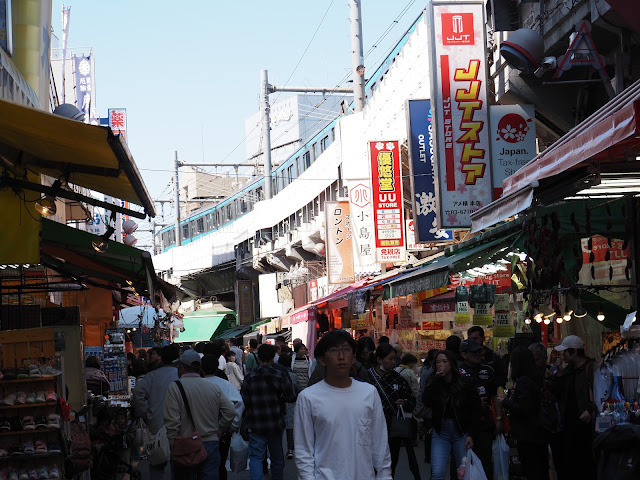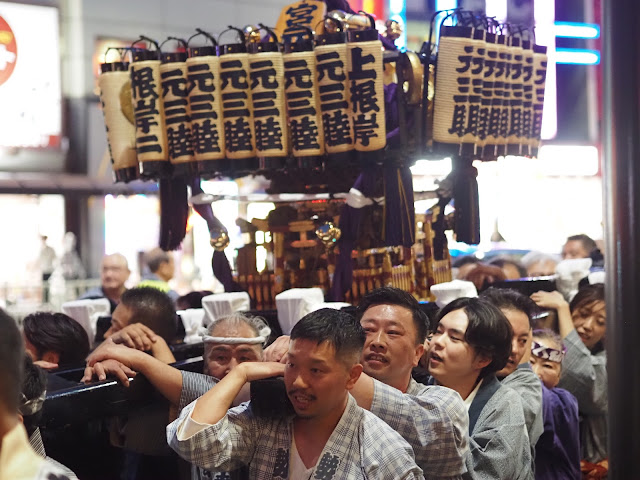In the shadows, welcoming spaces
Steam rises from a rice bowl draped with eel. A new constellation of bubbles rises in my beer glass every time a JR East train rumbles overhead. I am between Ueno and Okachimachi stations in northeastern Tokyo, where 400 shops are densely packed under the elevated JR tracks. It is called Ameyoko Shotengai, or Ameyoko shopping street.
Where I come from, city leaders consider such dark, forgotten underpasses dangerous and have dumped jagged rocks under them in the name of "safety." In Tokyo they are magnets of human activity. Lacking physical boundaries, these under-track areas are effortlessly integrated with surrounding streets. Members of the public come and go as they please.
Walking to Ameyoko took me through Ueno Park, which is always a good time. It is home to six museums, including the Tokyo National Museum; the National Museum of Nature and Science; and the National Museum of Western Art, pictured below.
The mysterious, unexcavated burial mound known as Suribachiyama. It is thought to be 1,500 years old.
Many school field trips are taking place here on this sunny afternoon.
At the Tower of Forgotten Time memorial, a girl points to American B-29s that are about to drop jelled gasoline bombs on Tokyo in March 1945.
Some 100,000 civilians were killed and a million others left homeless. The aftermath is dramatized in the new movie "Godzilla Minus One," which I saw last night at the 109Cinemas in Shinjuku. (I always thought Godzilla was some kind of protector of Japan, but he is a fucking menace to everyone. Check it out!)
Moms try to coax their babies to smile for a group photo.
A no-smoking area. Must be 20 years old to enter.
Like so many of Tokyo's contemporary commercial districts, the under-track areas were occupied by postwar squatters and black marketeers.
When the forcible removal of the unlicensed street stalls started in 1949, a businessman named Kondo Hirokichi built a market of temporary shelters in their place, each precisely 4.9 square meters in size. The Kondo Market was the forerunner to today's Ameyoko.
Ameyoko's tenants have autonomy to do what they like with their equal-sized lots. Unlike a mall, there is no branding strategy, no centralized management. The result is a lively atmosphere that any shopping mall would envy.
Ameyoko brings together clothing shops, fruit stands, fish retailers, bars and eateries. It's about six football fields long and draws tourists in large numbers.
I take the Keihin-Tohoku Line to Kando, and then the Chuo express to Koenji. It's all so seamless. I have never had to wait more than three minutes for a ride.
Koenji is one of Tokyo's most conspicuously bohemian suburbs. It dates to the 1920s.
The tracks were raised here in 1966 to reduce conflicts with Tokyo's growing mass car culture. I count about 70 shops under the iconic Chuo Line, but all is not well in the western under-track space, where vacancies are plentiful. I suppose business owners are getting old and successors are not easy to find.
Venturing away from the station, my appreciation for Koenji deepens. Lots of quiet residential streets, as well as pedestrian-only byways filled with live-music houses, secondhand stores, Iranian and Laotian restaurants.
A man takes his owl for a stroll. Fresh air is important.
An unusual-looking apartment block.
Mabashi Elementary School.
Tulip-themed pedestrian railings.
And many car-free zones ― the most reliable barometer of urban quality of life. I could see living here. It's a slower-paced, more affordable part of Tokyo.
A 6-foot-wide alley lined with bars and restaurants.
Tokyo is so vast, I could live here 100 years and still be pulled along by new undercurrents, steered into new settings. For me today it was the walkable, diverse setting of Koenji.
I have documented it for you, dear reader, in my little black book.































Comments
Post a Comment